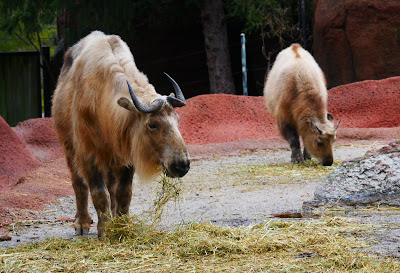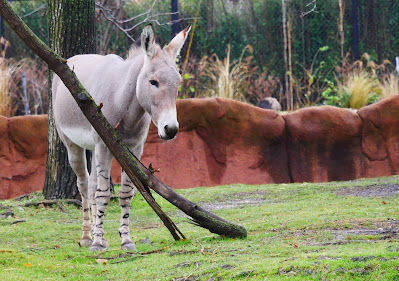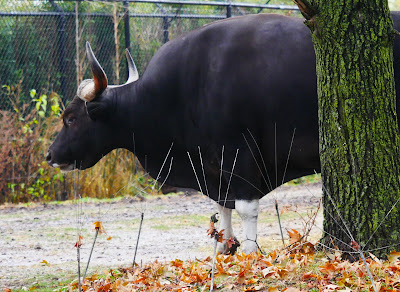With the coolness and especially the dampness (wet ground), not everyone was out. Most notably the Giraffe's, but once I saw their habitat and how sloping it is, I understood why. There is a real risk of injury when a Giraffe walks on a wet, sloping surface--they are designed for flat ground. Add in slippery wet grass, and it's not worth taking chances. Also MIA were the Okapi, the Speke's Gazelles, and the Gerenuks, which I had really wanted to see, but, alas.
Altogether, the Red Rocks hosts 24 separate exterior habitats, although a good third of them held duplicate species, suggesting that the animals are moved around (at least some of them) to give them a wider range of experiences outdoors. Toward the end of touring this area, I came upon a curious placard describing the AZA Stud Book and some information about the process of moving animals between zoos for breeding purposes. I have never seen that before, either. Bravo!
GREVY'S ZEBRA
The Grevy Zebra Habitat--first of two, this one for three females
Grevy's are very uniquely striped with slender, tightly arranged stripes making them easy to identify.
The lone male was housed in the adjacent habitat.
BACTRIAN CAMEL
The Bactrian Camel Habitat.
SICHUAN TAKIN
The Sichuan Takin Habitat
The magnificent bull with one of the females.
Another female with her offspring who was born just about a year ago.
Another Bull was slumbering on a rock ledge in an adjacent Habitat.
ADDAX
A Habitat with a little herd of Addax. Addax are extremely rare and on the verge of being extinct in the wild. Their survival as a species is completely in the hands of Zoos now in North America and Europe where there are collective breeding programs to maintain genetic diversity. I've only ever encountered them before at the Kansas City Zoo.
A young member of the group.
SOMALIA WILD ASS
Somalia Wild Ass
I find these critically endangered little equines so beautiful with their zebra stockings. I first encountered them at the Denver Zoo.
BANTENG
Banteng! These are wild cattle of Southeastern Asia, and based on their coloration, these are probably from a subspecies found on Java in Indonesia. They are critically endangered in the wild.
Beautiful huge Bull. Bulls are dark brown to black, distinguishing them from females.
SARUS CRANE
A pair of Sarus Crane shared the Banteng Habitat.
NILE LECHWE
Another first, a Nile Lechwe
SOEMMERRING'S GAZELLE
Soemmerring's Gazelle
The amazing ridged horns of the Impala, but much more intricate and varied face markings.
BLACK CROWNED CRANE
No Giraffe, but a pair of stunning Black Crowned Cranes.
TRANSCASPIAN URIAL
Transcaspian Urial Habitat
ADDRA GAZELLE
Parting Photo of a Addra Gazelle, another Critically Endangered animal from Africa's Sahel region.



































No comments:
Post a Comment